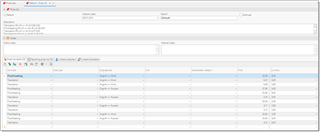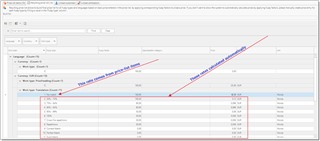Price-list is a set of prices which can be applied globally, to any customer or to any vendor. Price-lists can be default an optional. Default price-lists are used by default to determine prices while you’re editing quote items, job tasks and assignment tasks. You may have multiple default price-lists on application level, customer level and vendor level. Optional price-lists can be used in individual entities (quotes, translation jobs and translation assignments) if you explicitly select that price-list in the Price-list field.
To view price-lists, select Reference data > Price-lists in the navigation tree. To create a new price-list, click New on the ribbon (Ctrl-N on keyboard). To view/edit existing price-list, double click on it in the list.
Price-list editing
Default look of price-list window:

Default checkbox specifies if a price-list should be used as default on the global level. Such price-lists will be used for customers and vendors who don’t have any default price-lists attached to them.
Creation date is just a date when price-list was created. For reference purposes.
Name is a short name of a price-list to quickly differentiate it when selecting price-list in combo-boxes.
Archived checkbox allows to hide price-list from selection boxes.
Description is a field where you can provide detailed information about price-list. For example, values of base prices per work type or language. In the list of Customers and Vendors you may find Default prices column. When you attach price-list to a customer or vendor and make it default, value of this Description field will be displayed in the Default prices column. It allows to quickly understand prices of particular customer or vendor when you’re selecting them in drop-down lists.
Public notes and Internal notes allow to store some notes/reminders about price-list.
Price-list items is a table where you add price values. You can specify work type, fuzzy type, language pair, unit, specialization category and currency values, which determine where a particular price should be applied. When SDL Trados Business Manager will be picking up a price, it will search for closest match based on values provided in a source quote/job/assignment. If exactly matching price can’t be found, closest match will be used.
Example, you have two prices with identical set values, with the only difference in language (first price has no language pair specified, second price is for EN>DE language). If you enter a job with EN-DE language pair, then second price will be used. For any other language pair first price will be used.
When you’re creating new price-list, you can speed-up this process by loading price-list items from other price-list. To do this, click Load prices from another price-list button on the ribbon:

If you wish to create set of prices for another language pair, select price-list items and click Copy to another language… button on the toolbar and select new language pair in a popup window. In a result, selected price-list items will be cloned, and selected language pair will be selected in the Language pair column. Then, simply make changes in the Price column, as needed.
Fuzzy type isn’t mandatory field. Empty fuzzy type means that a price is for ‘No match’ fuzzy (100% weight). In this case SDL Trados Business Manager will read fuzzy weight from fuzzy scheme used in base entity and apply its weight to a price for ‘No match’ fuzzy to automatically calculate new price. This mechanism can be demonstrated by Resulting price-list tab. Contents of this tab is built on fly, based on Price-list items table, by applying fuzzy weights of all fuzzy types included in a default fuzzy scheme. This means that you can add one price for ‘No match’ fuzzy to the Price-list items table, switch to Resulting price-list and view automatically calculated prices for all fuzzy types. If you don’t wish the program to automatically calculate prices for fuzzy types, you can explicitly add price value to the Price-list items table for each fuzzy type. In the same manner, if you’re not happy with only one automatically calculated price (for example, only for ’50-74% fuzzy’), then you can manually add price only for this fuzzy type – in this case the application will automatically calculate prices only for rest fuzzy types.
For simplicity of viewing, data in the Resulting price-list table are grouped by Language pair, Currency and Work type:

And here is base price for the above screenshot entered in the Price-list items table (for empty language):

Such calculation works only when Unit value for a price-list item is not empty.
Hint. You can use Resulting price-list table in custom reports to build custom price-list reports for printing your prices. Example of such report is already included in the application (open list of customer or vendors, select any customer or vendor and click Print).
Linked customers tab shows list of customers who are linked with this price-list. To link a price-list with particular customer, open customer editing form, switch to Price-lists tab and click Add to link a price-list. When price-list was linked with a customer, that customer will appear on this Linked customers tab.
Linked vendors tab is analog of previous tab, but shows linked vendors.
Price-list list

This list displays all fields described in the previous section of this article. Additionally, there is Usage type column, which displays one of four values: Not used, Vendors, Customers or Both. This column allows to quickly determine how a particular price-list is used in the system, and it can be used for filtering the list.
On ribbon, you will find Open linked vendor and Open linked customer buttons. These buttons available only if you have one currently selected row and of selected price-list has any customer or vendor linked with it. As name says, this button allows to quickly open editing form of any customer or vendor linked with a currently selected price-list.
Archive button on the ribbon allows to quickly mark selected price-list(s) as archived. Archived price-list loose Default mark, if it’s checked.

 Translate
Translate